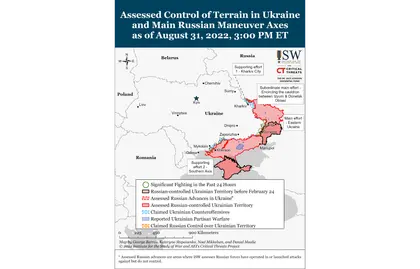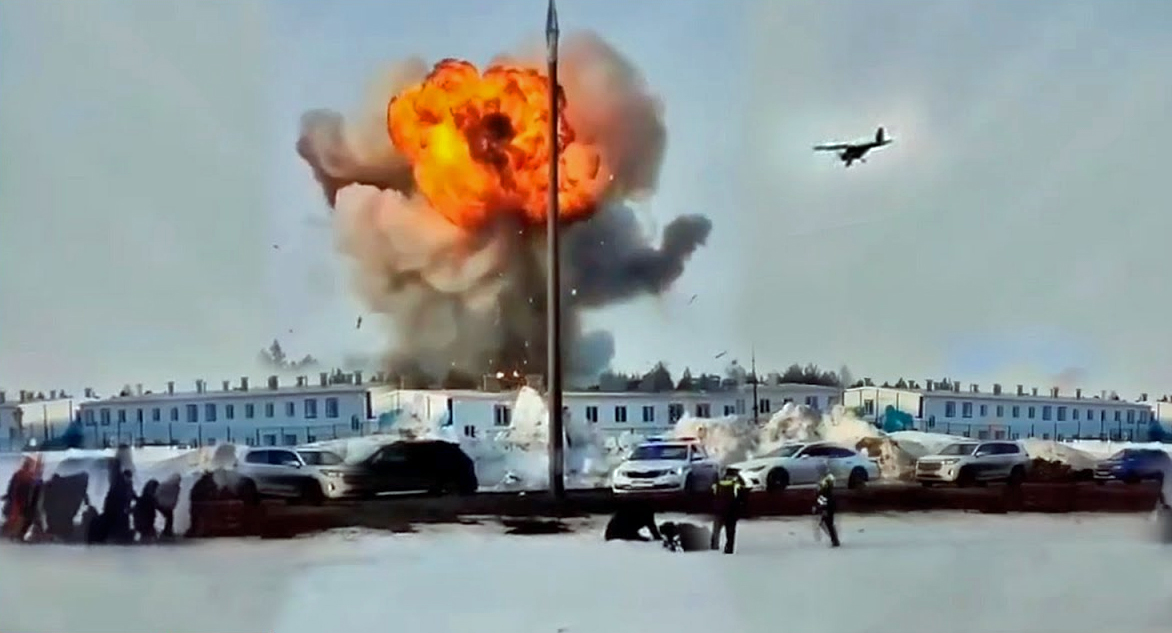Key Takeaways
- The Russian Ministry of Defense and Russian milbloggers began an information operation declaring the Ukrainian counteroffensive a failure almost as soon as it was launched. It is far too soon to assess the progress of the counteroffensive operation, however, which will likely be difficult to evaluate in the short term if it relies on feints and misdirection.
- Russian occupation authorities are imposing a curriculum on Ukrainian students aimed at eliminating the notion of Ukrainian national identity, explicitly in line with Russian President Vladimir Putin’s speeches and writings falsely claiming that Ukraine is part of Russia, and that the Ukrainian identity was an invention of the Soviet period.
- The G7 Non-Proliferation Directors Group condemned Russian attempts to disconnect the Zaporizhzhia Nuclear Power Plant from the Ukrainian power grid as “unacceptable” ahead of the arrival of the International Atomic Energy Agency (IAEA) delegation to the plant.
- Russian forces conducted a limited ground attack north of Kharkiv City.
- Russian forces conducted ground attacks south of Bakhmut and along the western outskirts of Donetsk City.
- Russian-appointed officials in Crimea began “reconstructing” air defense systems to counter smaller targets in response to recurring drone attacks on the peninsula. Russian officials are likely strengthening Crimean air defenses at the expense of other theaters.
- Zabaykalsky Krai announced the formation of the “Daursky” volunteer engineer-sapper battalion.
- Ukrainian partisans conducted an improvised explosive device (IED) attack against the headquarters of the “Together with Russia” political organization in Berdyansk, Zaporizhia Oblast, where occupation authorities were reportedly preparing for sham referenda.
Ukrainians and the West should not fall for Russian information operations portraying the Ukrainian counteroffensive in Kherson Oblast as having failed almost instantly or that depict Ukraine as a helpless puppet of Western masters for launching it at this time. The Russian Ministry of Defense began conducting an information operation to present Ukraine’s counteroffensive as decisively failed almost as soon as it was announced on August 29.[1] Several prominent military bloggers—even bloggers who have historically been critical of the Kremlin—are promoting this message.[2] Other milbloggers are additionally promoting the narrative that Ukraine’s Western handlers pushed Ukraine to launch the counteroffensive prematurely and/or too late for “political” reasons and because the West expected a counteroffensive.[3] Kremlin media outlets have also centrally amplified allegations of civil-military conflict between Ukrainian President Volodymyr Zelensky and Ukrainian Commander-in-Chief Valerii Zaluzhnyi to bolster the narrative that Zelensky sought to conduct a counteroffensive for inappropriate political reasons whereas Zaluzhnyi assessed Ukrainian forces were not militarily prepared to do so.[4]
JOIN US ON TELEGRAM
Follow our coverage of the war on the @Kyivpost_official.
Military operations on the scale of this counteroffensive do not succeed or fail in a day or a week. Ukrainian officials have long acknowledged that they do not have the sheer mass of mechanized forces that would have been needed to conduct a blitzkrieg-like drive to destroy the Russian defenses in Kherson Oblast or anywhere. They have instead been setting conditions for months by attacking and disrupting Russian ground lines of communication (GLOCs), Russian command and control, and Russian logistics systems throughout southwestern occupied Ukraine. The timing of the start of the counteroffensive is consistent with the observed degradation of Russian capabilities in western Kherson Oblast balanced against the need to start liberating occupied Ukrainian lands and people as soon as possible. There is no reason to suspect that the timing has been materially influenced by inappropriate considerations or tensions. Counteroffensive operations now underway will very likely unfold over the coming weeks and possibly months as Ukrainian forces take advantage of the conditions they have set to defeat particular sectors of the line they have identified as vulnerable while working to retake their cities and towns without destroying them in the process.

Christmas Thoughts Inspired by John Lennon, and the Enemy of Peace
Military forces that must conduct offensive operations without the numerical advantages normally required for success in such operations often rely on misdirections and feints to draw the defender away from the sectors of the line on which breakthrough and exploitation efforts will focus. The art of such feints is two-fold. First, they must be conducted with sufficient force to be believable. Since they are feints, however, rather than deliberate attacks expected to succeed, they often look like failures—the attacking units will fall back when they feel they have persuaded the defender of their seriousness. Second, they take time to have an effect. When the purpose of the feint is to draw the defender’s forces away from the intended breakthrough sectors, the attacker must wait until the defender has actually moved forces. There will thus likely be a delay between the initial feint operations and the start of decisive operations. The situation during that delay may well look like the attack has failed.
The Ukrainian military and government are repeating requests to avoid any reporting or forecasting of the Ukrainian counteroffensive, a measure that is essential if the counteroffensive includes feints or misdirections.[5] It is of course possible that the counteroffensive will fail, that any particular breakthrough attempt that fails was not a feint, or that the Ukrainian military has made some error in planning, timing, or execution that will undermine the success of its operations. But the situation in which Ukraine finds itself calls for a shrewd and nuanced counteroffensive operation with considerable misdirection and careful and controlled advances. It is far more likely in these very early days, therefore, that a successful counteroffensive would appear to be stalling or unsuccessful for some time before its success became manifest.
ISW and other analysts studying this war have been appropriately cautious and circumspect in announcing the culmination or defeat of major Russian offensive operations. ISW will apply the same caution and circumspection to assessing the progress of the Ukrainian counteroffensive and exhorts others to do the same.
Russian authorities released a list of the locations of schools in occupied areas, including precise coordinates, ostensibly warning of possible Ukrainian attacks against them as the school year begins on September 1. This announcement could be preparation for Russian false-flag attacks on schools, for an explanation of very low attendance, or for some other purpose. The Russian Defense Ministry (MoD) issued a statement on August 31 warning that Ukrainian forces are preparing to shell schools in occupied Donetsk, Luhansk, Kharkiv, Kherson, and Zaporizhia oblasts.[6] The Russian MoD released a list of the addresses and exact locations of all schools in occupied areas of Ukraine under the pretext of “ensuring the safety of students and teachers.”[7] This statement, along with the list of schools in occupied areas, could be an attempt to set information conditions for three potential courses of action on September 1. The first, and most dangerous, may be a preparation for Russian troops to stage a false-flag attack against educational infrastructure in occupied areas of Ukraine and blame the Ukrainian armed forces for the attack. The second scenario, which is more likely, is that Russian authorities may be setting conditions to explain very low enrollment and attendance in Russian-run schools as the school year begins. As ISW reported on August 30, Ukrainian families with children have been increasingly leaving Russian-occupied areas of Ukraine as the school year approaches.[8] Russian authorities may seek to amplify the claimed threat of Ukrainian strikes against schools in order to explain low attendance levels. The third scenario is that Russian authorities could be attempting to establish a published no-strike list by identifying specific civilian infrastructure, which will later allow them to use the identified schools as military bases with the expectation that Ukrainian forces will not target designated civilian infrastructure.
Russian authorities are additionally using the start of the new school year to escalate efforts to institutionalize the elimination of Ukrainian identity. Russian authorities continued to disseminate Russian educational materials in schools in occupied areas of Ukraine. Russian-backed authorities from Sevastopol arrived in Starobilsk, Luhansk Oblast, to deliver backpacks and official state symbols of the Russian Federation to local schools.[9] The Russian-appointed head of Crimea, Sergey Aksyonov, similarly called on educators in Crimea to intensify patriotic programming in Crimean schools, notably to teach children about Russian President Vladimir Putin’s decision to conduct a “special military operation” in Ukraine.[10] Ukrainian outlet Strana reported that the first lesson that will be taught in schools in occupied Donetsk and Luhansk oblasts is oriented on a lesson outline that pulls from Putin’s article on “The Historical Unity of Russians and Ukrainians”, his speeches on the recognition of the Donetsk and Luhansk People’s Republics (DNR and LNR), and the commencement of the “special military operation.”[11] In these speeches, Putin rejected the legitimacy of Ukrainian identity, declaring that it “is entirely the product of the Soviet era… shaped on the lands of historical Russia.”[12] He also repeatedly declared that Ukraine is part of Russia and cannot be a state in its own right. The explicit link between Russian-imposed curricula in Ukrainian schools and these speeches and writings is part of an effort to erase the Ukrainian identity in Russian-occupied parts of Ukraine through educational control.[13]
The G7 Non-Proliferation Directors Group stated that Russian attempts to disconnect the Zaporizhzhia Nuclear Power Plant (ZNPP) would be “unacceptable,” ahead of the International Atomic Energy Agency (IAEA) delegation’s visit to the plant.[14] The G7 Non-Proliferation Directors Group noted that the ZNPP should not be used for military activities or the storage of military material. Satellite imagery provided by Maxar previously showed Russian combat vehicles sheltering under the ZNPP infrastructure very close to a reactor vessel.[15]
Russian and Ukrainian sources again exchanged accusations of shelling and loitering munition strikes on Enerhodar on August 31. Kremlin-sponsored sources claimed that Ukrainian forces conducted an unmanned aerial vehicle (UAV) strike on the Enerhodar City Council building, and Ukrainian officials stated that Russian forces shelled the building in an effort to frame Ukrainian forces ahead of the IAEA visit.[16]
Authors: Kateryna Stepanenko, Karolina Hird, George Barros, and Frederick W. Kagan
See the full report here.
You can also highlight the text and press Ctrl + Enter






